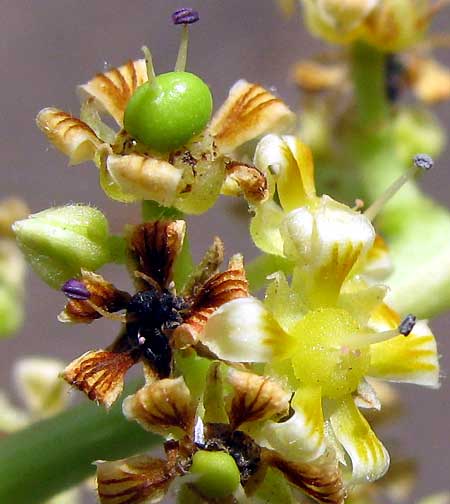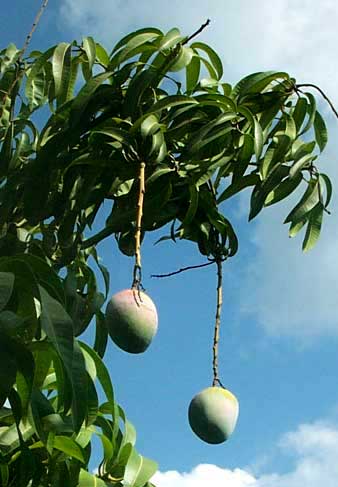
In the late dry season, in April or so, the Mango tree, Mangifera indica, -- which can grow to be fairly large -- draws attention to itself with foot-long panicles of tiny, white flowers at the end of branches equipped with slender, foot-long leaves with herring-bone venation as shown below:

Mango trees are members of the Cashew Family, the Anacardiaceae, along with not only Cashews but also Pistachios, the sumacs, and Poison Oak and Poison Ivy. Flowers in the family typically bear 3-5 petals and have their ovaries perched atop "annular disks," which are doughnut-shaped things in the flower's center. Flowers can be unisexual or bisexual. Mango flowers display all those features of the family, plus they add some interesting innovations. You can see a small cluster of them below.

In that picture, in the flower at the top, left, the green, spherical ovary -- the future mango -- is easy to make out. Mango ovaries are unusual in that their styles don't emerge from their centers, but rather a bit to one side. You may have noticed that the resulting mango fruits are a bit lopsided, too. Note behind that flower's ovary that there's a single stamen, its dark purple, pollen-producing anther attached atop a pale, slender filament. Some mango flowers may have up to five stamens, but usually only one or two are fertile, the others hardly developing. All the flowers examined on the tree producing these flowers bore only a single stamen, and in the flower world that's an unusual situation.
Notice the younger flower in the picture's lower right. That blossom has no ovary at all. It's strictly a male, unisexual flower. The yellow structure in the center is the annular disk. The dark flower to the left is similarly a male, unisexual flower in which the stamen and annular disk have shriveled up. When a plant bears unisexual flowers mixed with flowers bearing both male and female parts, the plant is said to be polygamous.
 In each many-flowered panicle, all male flowers shrivel and fall off leaving nothing behind, and all but a few female flowers also shrivel and fall. In the end, each panicle bears only one or two fruits. Most flowers with ovaries, even if they get pollinated, abort, leaving only the strongest to mature into fruits. Well into the rainy season, in July or thereabouts, fruits appear on trees, as shown at the right.
In each many-flowered panicle, all male flowers shrivel and fall off leaving nothing behind, and all but a few female flowers also shrivel and fall. In the end, each panicle bears only one or two fruits. Most flowers with ovaries, even if they get pollinated, abort, leaving only the strongest to mature into fruits. Well into the rainy season, in July or thereabouts, fruits appear on trees, as shown at the right.
Mango trees, though found all over Mexico, are native to northern India, Burma and Malaya.